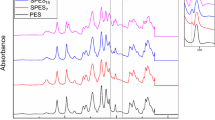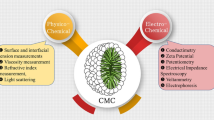Abstract
Four siloxane polyether surfactants were synthesized from allyl bromide, polyethylene glycol methyl ether and heptamethyltrisiloxane (HMTS) to explore their solubility in CO2. The dissolving pressures of these surfactants were measured using a high-pressure view cell at 318–343 K to calculate their solubility in CO2. The results show that, the silicone-containing surfactants exhibit excellent solubility in CO2. The shorter the polyethylene glycol group, the better the solubility in CO2. Of the five compounds tested, HMTS showed the best solubility in CO2 which was around 2.4% as a mole percentage. The surfactants show much better solubility than the commonly used surfactants. Moreover, by investigating the effects of the pressure and temperature on the solubility, it was found that an increase in pressure benefits solubility of the compound in CO2, while an increase in temperature within the experimental range does the opposite. In addition, a linear correlation in the logarithmic values of the solubility data and the density of CO2 was found, which means the solubility follows density more directly and not the pressure.




Similar content being viewed by others
References
Melo MMR, Silva RP, Silvestre AJD, Silva CM. Valorization of water hyacinth through supercritical CO2 extraction of stigmasterol. Ind Crops Prod. 2016;80:177–85.
Cavalcanti RN, Albuquerque CLC, Meireles MAA. Supercritical CO2 extraction of cupuassu butter from defatted seed residue: experimental data, mathematical modeling and cost of manufacturing. Food Bioprod Process. 2016;97:48–62.
Bucio SL, Sanz MT, Beltrán S, Melgosa R, Solaesa ÁG, Ruiz MO. Study of the influence of process parameters on liquid and supercritical CO2 extraction of oil from rendered materials: fish meal and oil characterization. J Supercrit Fluids. 2016;107:270–7.
Casciato MJ, Kim S, Lu JC, Hess DW, Grover MA. Optimization of a carbon dioxide-assisted nanoparticle deposition process using sequential experimental design with adaptive design space. Ind Eng Chem Res. 2012;51:4363–70.
Bachu S. Identification of oil reservoirs suitable for CO2-EOR and CO2 storage (CCUS) using reserves databases, with application to Alberta, Canada. Int J Greenh Gas Con. 2016;44:152–65.
Ren B, Zhang L, Huang H, Ren S, Chen G, Zhang H. Performance evaluation and mechanisms study of near-miscible CO2 flooding in a tight oil reservoir of Jilin Oilfield China. J Nat Gas Sci Eng. 2015;27:1796–805.
Bikkina P, Wan J, Kim Y, Kneafsey TJ, Tokunaga TK. Influence of wettability and permeability heterogeneity on miscible CO2 flooding efficiency. Fuel. 2016;166:219–26.
Kazarian SG, Vincent MF, Bright FV, Liotta CL, Eckert CA. Specific intermolecular interaction of carbon dioxide with polymers. J Am Chem Soc. 1996;118:1729–36.
Ren G, Sanders AW, Nguyen QP. New method for the determination of surfactant solubility and partitioning between CO2 and brine. J Supercrit Fluids. 2014;91:77–83.
O’Shea KE, Kirmse KM, Fox MA, Johnston KP. Polar and hydrogen-bonding interactions in supercritical fluids: effects on the tautomeric equilibrium of 4-(phenylazo)-1-naphthol. J Phys Chem. 1991;95:7863–7.
McClain JB, Betts DE, Canelas DA, Samulski ET, DeSimone JM, Londono JD, Cochran HD, Wignall GD, Chillura-Martino D, Triolo R. Design of nonionic surfactants for supercritical carbon dioxide. Science. 1996;274:2049–52.
Jimeń ez-Carmona MM, Luque de Castro MD. Reverse-micelle formation: a strategy for enhancing CO2-supercritical fluid extraction of polar analytes. Anal Chim Acta. 1998;358:1–4.
Goetheer ELV, Vorstman MAG, Keurentjes JTF. Opportunities for process intensification using reverse micelles in liquid and supercritical carbon dioxide. Chem Eng Sci. 1999;54:1589–96.
Iezzi A, Enick R, Brady J. Direct viscosity enhancement of carbon dioxide. Supercritical fluid science and technology. ACS symposium series. Washington, D.C.: American Chemical Society; 1989; Vol 406: p. 122–139.
Ritter JM, Paulaitis ME. Multiphase behavior in ternary mixtures of CO2, H2O, and nonionic amphiphiles at elevated pressures. Langmuir. 1990;6:934–41.
Consani KA, Smith RD. Observations on the solubility of surfactants and related molecules in carbon dioxide at 50°C. J Supercrit Fluids. 1990;3:51–65.
Liu Z, Erkey C. Water in carbon dioxide microemulsions with fluorinated analogues of AOT. Langmuir. 2001;17:274–7.
Gao Y, Wu W, Han B, Li G, Chen J, Hou W. Water-in-CO2 microemulsions with a simple fluorosurfactant. Fluid Phase Equilib. 2004;226:301–5.
Klostermann M, Strey R, Sottmann T, Schweins R, Lindner P, Holderer O, Monkenbusch M, Richter D. Structure and dynamics of balanced supercritical CO2-microemulsions. Soft Matter. 2012;8:797–807.
Johnston KP, Harrison KL, Clarke MJ, Howdle SM, Heitz MP, Bright FV, Carlier C, Randolph TW. Water-in-carbon dioxide microemulsions: an environment for hydrophiles including proteins. Science. 1996;271:624–6.
Nave S, Eastoe J, Heenan RK, Steytler D, Grillo I. What is so special about aerosol-OT? 2. Microemulsion systems. Langmuir. 2000;16:8741–8.
Lee CT Jr, Ryoo W, Smith PG Jr, Arellano J, Mitchell DR, Lagow RJ, Webber SE, Johnston KP. Carbon dioxide-in-water microemulsions. J Am Chem Soc. 2003;125:3181–9.
Beckman EJ. A challenge for green chemistry: designing molecules that readily dissolve in carbon dioxide. Chem Commun. 2004; 1885–1888.
Hoefling TA, Newman DA, Enick RM, Beckman EJ. Effect of structure on the cloud-point curves of silicone-based amphiphiles in supercritical carbon dioxide. J Supercrit Fluids. 1993;6:165–71.
Fink R, Hancu D, Valentine R, Beckman EJ. Toward the development of “CO2-philic” hydrocarbons. 1. use of side-chain functionalization to lower the miscibility pressure of polydimethylsiloxanes in CO2. J Phys Chem B. 1999;103:6441–4.
da Rocha SRP, Harrison KL, Johnston KP. Effect of surfactants on the interfacial tension and emulsion formation between water and carbon dioxide. Langmuir. 1999;15:419–28.
Johnston KP, Holmes JD, Jacobson GB, Lee CT, Li G, Psathas P, Yates MZ. Reactions and synthesis in surfactant systems. In: Texter J, editor. Reactions and synthesis in microemulsions and emulsions in carbon dioxide. New York: Marcel Dekker; 2001. p. 359–72.
da Rocha SRP, Psathas PA, Klein E, Johnston KP. Concentrated CO2-in-water emulsions with nonionic polymeric surfactants. J Colloid Interface Sci. 2001;239:241–53.
Kunieda H, Taoka H, Iwanaga T, Harashima A. Phase behavior of polyoxyethylene trisiloxane surfactant in water and water–oil. Langmuir. 1998;14:5113–20.
Shi Q, Jing L, Qiao W. Solubility of n-alkanes in supercritical CO2 at diverse temperature and pressure. J CO2 Util. 2015;9:29–38.
Speier JL, Webster JA, Barnes GH. The addition of silicon hydrides to olefinic double bonds. II. The use of group viii metal catalysts. J Am Chem Soc. 1957;79:974–9.
Shi Q, Jing L, Xiong C, Liu C, Qiao W. Solubility of nonionic hydrocarbon surfactants with different hydrophobic tails in supercritical CO2. J Chem Eng Data. 2015;60:2469–76.
Zhang Y, Zhang L, Wang Y, Wang M, Wang Y, Ren S. Dissolution of surfactants in supercritical CO2 with co-solvents. Chem Eng Res Des. 2015;94:624–31.
Chrastil J. Solubility of solids and liquids in supercritical gases. J Phys Chem. 1982;86:3016–22.
Acknowledgements
The authors greatly appreciate the support (Grant DQYT- 0508003-2012-JS-362) given by the Petro China Daqing Oilfield Co., Ltd.
Author information
Authors and Affiliations
Corresponding author
Electronic supplementary material
Below is the link to the electronic supplementary material.
About this article
Cite this article
Shi, Q., Qiao, W. Synthesis of Siloxane Polyether Surfactants and Their Solubility in Supercritical CO2 . J Surfact Deterg 20, 453–458 (2017). https://doi.org/10.1007/s11743-016-1912-x
Received:
Accepted:
Published:
Issue Date:
DOI: https://doi.org/10.1007/s11743-016-1912-x




